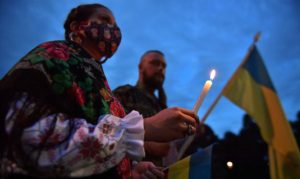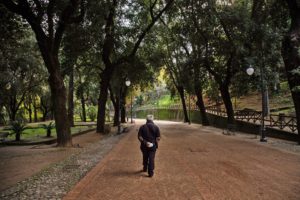It is almost exactly two years ago that we were first asked to stand on our doorsteps to clap for NHS staff. As the weeks went on, the target of our applause was widened: to healthcare workers and emergency services, the Clap for Our Carers website added: “armed services, delivery drivers, shop workers, teachers, waste collectors, manufacturers, postal workers, cleaners, vets, engineers … bravo you are amazing!”
A funeral director friend — a woman whose job depends on not becoming too emotional — was livid at the omission. Clap for Our Carers celebrated “all those who are out there making an unbelievable difference to our lives in these challenging times”. Meanwhile, those making an unbelievable difference to our deaths were ignored, even though their times were just as challenging, if not more so.
It was not so much the case numbers — one of Amanda’s biggest grumbles was constantly tripping over the coffins she panic-bought in March, didn’t use, and had to store in the staff kitchen — but the ludicrous Covid theatre she had to choreograph. Instead of meeting families for tea and sympathy, she was giving advice over Zoom on strategies for deciding which ten people would make the cut, and whether these ten were allowed to place a rose on the coffin individually so long as they were socially distanced. And then, after she gave the correct answer — “No, but do it anyway” — there was the tedium of fighting with crematorium staff threatening to blacklist her.
Funeral directors weren’t even on the Government’s list of Key Workers when it was first introduced. Those who deal with the dead were forgotten, even when the shadow of death was over the whole country. It was not deliberate suppression of the facts, like the mobile crematoria rumoured to be following the Russian front line to keep reality at a distance from people back home; it simply never occurred to the authorities to think about who and what comes after death.
Someone who does think about the who and what is Hayley Campbell. Her new book, All the Living and the Dead, is a series of profiles of “death workers” — not just funeral directors, but embalmers, grave diggers, anatomists and, in one haunting chapter, an executioner. There is a huge emphasis on the physical: her chapter on the work of funeral directors is about the act of changing the clothes on a body, not the counselling or event organising (“all the work of a wedding planner but done in a week”) or the constant state of war with crematorium staff — the work that takes up most of a funeral director’s time. Funeral celebrants are not mentioned at all.
A couple of years ago, I interviewed a range of people from the funeral industry; and one of my standard questions was “What is a funeral for?” (The other one was “Who is a funeral for?”) It wasn’t until the very last interview that someone said, “to dispose of the body”, and I realised that everyone had been skipping over the one thing that defines a funeral, like those restaurant reviewers who never mention the food. The whole point of a funeral is that it gets the body where it needs to be — a physical presence that we can cope with, buried or processed into ash.
Campbell doesn’t make that mistake. She has a whole chapter about what happens in crematoria. The part that will stay with me longest — possibly because both my parents died of cancer — is that a tumour takes longer to turn to ash than the rest of the body, unyielding while everything else is burnt away, like St Paul’s Cathedral during the Blitz. The operator has to fire jets directly at the lump — “almost like black coral” — until it too is dust.
Still, the book doesn’t talk about what happens to the ashes after they’ve gone through the cremulator and become powder. It is as if Campbell loses interest in human remains at the moment most of us can face up to them: when they are no longer recognisable as a body. She interviews a specialist in the niche and rather creepy art of death masks — “Nick thought that the popularity of death masks was on the rise… But it never really took off” — but doesn’t examine the growing industry surrounding ashes that have been safely unbodied.
There is no mention of the companies that will send them into the heavens in fireworks; or turn them into diamonds, pencils, vinyl records or tattoos; or pour them into hourglasses (“They cannot be exactly timed, due to the consistency of the cremains”); or mix them with concrete to create habitats for fish in coral reefs; or of the company in Alabama which will place them “with care and reverence into almost any caliber or gauge of ammunition”. Or, if you want niche and rather creepy, vibrators.
There is money in achieving the impossible — giving you a physical reminder of someone that isn’t a physical reminder of them. Perhaps the reason death masks never took off was that they are too good a reminder. Although it is worth noting that one high-profile British politician did commission one of his late father: Jacob Rees-Mogg.
It was different when ours was a Christian society, but we now find it difficult to admit that our bodies are what we are. The most popular reading at funerals is now the dreadful “Do not stand at my grave and weep”, which suggests that the deceased is wind or sunlight or glints in snow — anything but the body being buried. It’s a bit of doggerel so mawkish and vacuous that Ricky Gervais used it as the emotional climax to his telly show about death. The first time I laughed after my mother’s death was when a priest, to whom I had sarcastically suggested it as a reading, read it all the way to “I am not here / I did not die,” the final lines, before handing it back and saying, “Well, the crematorium’s going to be a hell of a shock, isn’t it?”
Campbell, though, doesn’t shy away from the physicality of dead bodies — the smell of putrefaction, and why it smells like a gas leak; the sound of rigor snapping — and how they are physically handled. In many ways, emphasising the physicality is healthier than ignoring it: in a disaster, Campbell points out, those who actively do something are at much lower risk of becoming traumatised, as they are using their stress hormones for their proper purpose, than those who stand by. (On a smaller scale, it was felt deeply by my cousins that they were not allowed to carry my uncle’s coffin at his funeral, because of the social distancing rules, which everyone knew would be totally ignored at the subsequent wake.)
But, in a post-Christian society, it’s just as easy to ignore the fact we are not just our bodies. Most of the death workers Campbell interviews do this to a certain extent because they need to separate these bodies from their identities — technicians in the autopsy room who can weigh organs so long as they know nothing about the person whose body it is; crematorium workers who can pitch someone into a fire but find dressing them too personal.
The executioner is the only death worker in the book who knew the bodies in his charge equally well when they were alive — execution was among his duties as a prison guard. He is also the only one who believes in God. This is not a coincidence. Campbell dismisses this as wishful thinking: “God is the soft focus everyone [involved in an execution] puts on the scene… to me, it says they’re choosing not to think too deeply on whatever it is they’re doing because it doesn’t matter.” To me, it says something very different. He believes because he knows that death does matter. It is the rest of us who are looking in soft focus.
Disclaimer
Some of the posts we share are controversial and we do not necessarily agree with them in the whole extend. Sometimes we agree with the content or part of it but we do not agree with the narration or language. Nevertheless we find them somehow interesting, valuable and/or informative or we share them, because we strongly believe in freedom of speech, free press and journalism. We strongly encourage you to have a critical approach to all the content, do your own research and analysis to build your own opinion.
We would be glad to have your feedback.
Source: UnHerd Read the original article here: https://unherd.com



